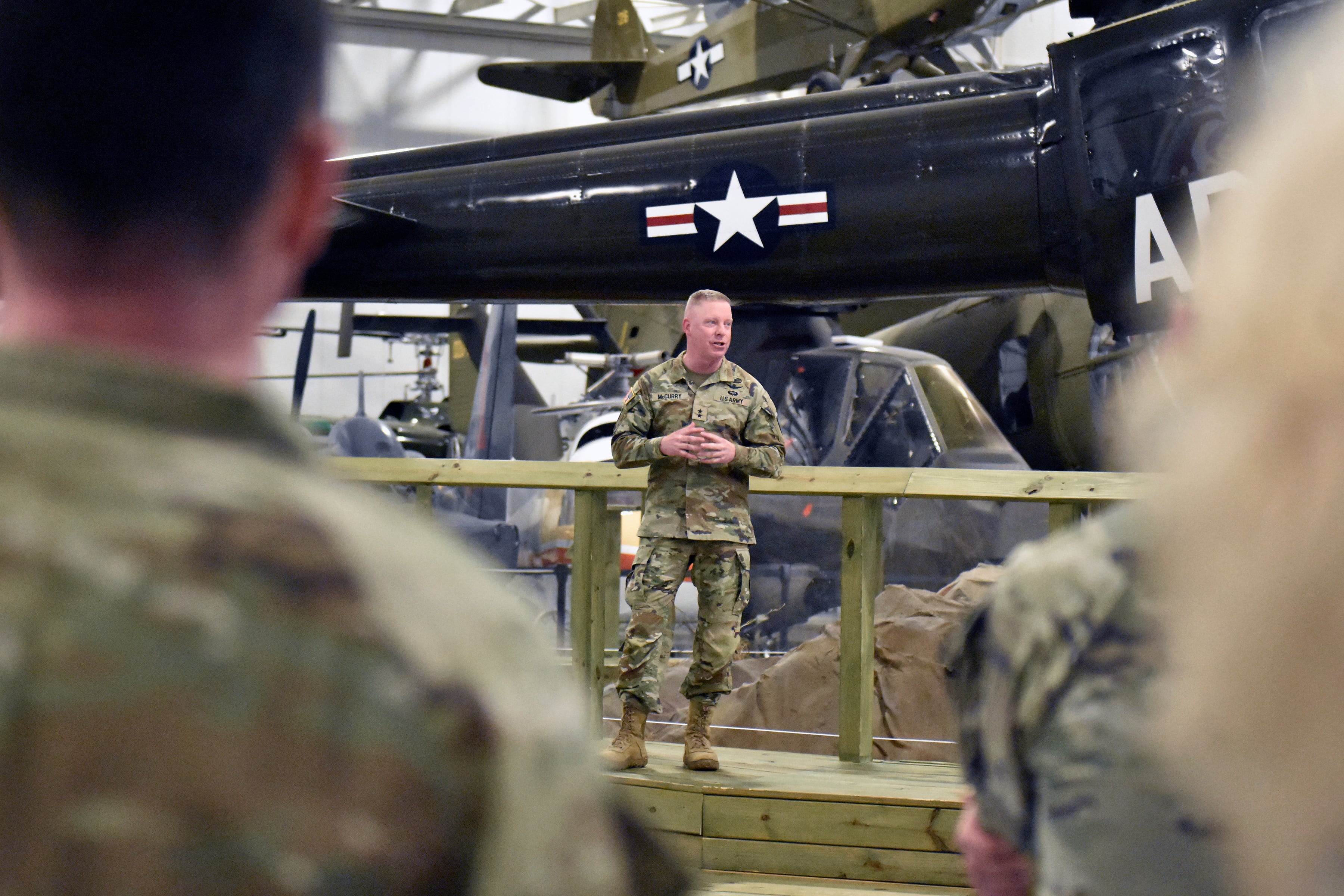Army aviators and ground commanders face challenges of farther distances to travel, enemy systems that can strike aircraft and ground forces and a very crowded airspace.
A combination of efforts happening at multiple centers of excellence — which are responsible for establishing protocols across specific areas — seeks to tackle those problems, though not without some challenges.
The commander of the Aviation Center of Excellence, Maj. Gen. Michael McCurry, spoke at the September Maneuver Warfighter Conference at Fort Moore, Georgia and shared some of his observations as well as a future-focused plan.
The two-star noted that studies a few years ago, predating the Russia-Ukraine War, showed that Army aircraft staging areas were too close to the fight. All of them could be reached by enemy long-range fires and some by drones.
That development alone is a radical departure from how aviators during the height of the Global War on Terror operated.
That meant that aviators could no longer park their aircraft within a few dozen kilometers of combat and simply sweep the skies above nearby forward operating bases looking for small groups of enemy fighters. They were only able to get away with that because, until recently, those enemy combatants had no airpower or long-range fires of their own. China, Russia, Iran and North Korea have their own arsenals to strike 100km or more, if needed, and their own air defenses to see U.S. aircraft coming.
“It’s not two Apaches hovering around waiting for a call,” McCurry said.
In the future, that will affect how ground commanders operate. Air assets will be in high demand and traveling a lot. That means that ground units may need to solve some of their own air problems, said the Maneuver Center of Excellence commander, Maj. Gen. Curtis Buzzard.
Buzzard recalled how during GWOT, small arms fire from a tree line harassing three companies of soldiers might have meant that helicopters supporting an armored force elsewhere might be pulled in to respond for such a minor threat.
“We’ve got to get off that so that unit take care of their own problems,” he said, using assets they already have in the formation, such as future small drone platforms or loitering munitions.
Program Executive Office-Soldier recently took on the Low Altitude Stalking and Strike Ordnance, or LASSO program this year. The program will field a man-packable loitering munition for lower-echelon units.
With the pending introduction of new platforms, Future Attack Reconnaissance Aircraft and Future Long Range Assault Aircraft into the formations, Army aviation leaders expect the ability to travel as far as 200 nautical miles each way to transport and support ground troops.
At the same time, the airspace they fly is looking more congested.
In 2021, Army aviation joined other military services in a joint project with Defense Advanced Research Projects Agency dubbed “Air Space Total Awareness for Rapid Tactical Execution,” an airspace deconfliction software.
That’s because both the proliferation of enemy drones and the growing use of a host of drones at varying altitudes and ranges by friendly forces is creating a crowded arena for pilots.
The deconfliction includes not just aircraft and drones but also incorporates missile and artillery fire in contested airspace, according to DARPA materials. Phase 3 testing for the program took place this past summer.
Another initiative on the drone front includes the Joint Counter Small Unmanned Aerial Systems University, which is set to reach initial operational capability in October.
The counter-drone training program kicked off this year and is already offering operator, planning and installation protection courses at the Fires Center of Excellence in Fort Sill, Oklahoma, said the center’s commander, Maj. Gen. Phil Brooks, also at the September conference.
At the same time, McCurry said that a working group that included all the centers of excellence reviewed the needs of each of the centers within drone use this past year.
Working with the Maneuver Center of Excellence, McCurry said that open architecture systems are crucial to getting after what the Army wants across the formations.
“We need a system doing [intelligence, surveillance and reconnaissance] today, sustainment tomorrow out to the front lines where you are,” McCurry said.
Some of that work will be automated, but, McCurry said, not all of it will be, and not for a long time.
The two-star said a recent outside study on automating cavalry unit reconnaissance and surveillance work showed that by 2040 such units would still only have less than half of those tasks fully automated.
That means a lot of work is left for the human soldiers in those formations as new technology is added.
“We still require that natural curiosity, intuition and decision making,” McCurry said.
Todd South has written about crime, courts, government and the military for multiple publications since 2004 and was named a 2014 Pulitzer finalist for a co-written project on witness intimidation. Todd is a Marine veteran of the Iraq War.





